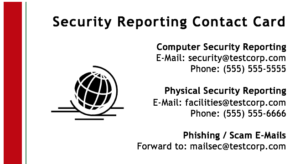 After a really nice weekend, Zeke walked into his office and logged into his workstation. He made a habit of getting to the office around 7 AM on Mondays so that he could go through the pile of unanswered e-mails from the previous week and clear out all junk that accumulated over the weekend. As he was going through e-mails, he spotted one with the subject line “401k performance highlights” that was sent towards the end of the day on Friday. He had seen it then, but was in a rush to get out the door. He opened the e-mail and read that his 401k had performed better than expected over the previous quarter. A link was provided to review the details so he clicked it. That was when he realized he had made a mistake.
After a really nice weekend, Zeke walked into his office and logged into his workstation. He made a habit of getting to the office around 7 AM on Mondays so that he could go through the pile of unanswered e-mails from the previous week and clear out all junk that accumulated over the weekend. As he was going through e-mails, he spotted one with the subject line “401k performance highlights” that was sent towards the end of the day on Friday. He had seen it then, but was in a rush to get out the door. He opened the e-mail and read that his 401k had performed better than expected over the previous quarter. A link was provided to review the details so he clicked it. That was when he realized he had made a mistake.
The link didn’t go to his 401k provider as expected, but instead went to a suspicious looking fake site that was made to look like it. Zeke had gone through information security awareness training, so he knew how to spot forgeries like this. It was very obvious that the site was hosted on a domain made to look like a legitimate bank, but was in fact not associated with it at all. He immediately closed his browser window and waited. His system seemed to be fine. No weird pop ups, no prompts to download any software, no weird slowness. He had dodged a bullet. He remembered that he was supposed to report occurrences like this, but wasn’t entirely sure where. Was it the IT helpdesk? No, it was a special e-mail address….or was it a phone number? He quickly looked up the contact number for someone he knew who worked in information security. Hmm, no answer. It’s still pretty early so that person might not be in. He shrugged it off and went about the business of responding to unanswered mail. By the time his day got going, he forgot all about the incident and it never got reported.
Stories like the one here are common in large organizations. Many companies do their part and invest heavily in security awareness programs that teach employees how to spot phishing attempts and security anomalies so that they can be reported. However, many organizations struggle with the final step in this process — effectively enabling their users to report anomalous activity.
So, why do users fail to report security issues when they recognize them? You might expect me to provide a long-winded underlying psychology perspective. However, the answer is much simple than that. People rarely have the opportunity to report security incidents, so they forget how to do it. Just like Zeke, they forget the e-mail address or the phone number. Further, they are often hesitant about whether anyone actually cares about what they’ve observed, and they’re worried that incompetence will be exposed. Of course, there isn’t incompetence here, but all that matters is that the individual perceives the possibility of it. Nobody likes feeling dumb, so someone certainly aren’t going to go out of their way to report an incident if it means potentially going through multiple layers of people. That increases the chance that perceived incompetence gets exposed. In summation, people are less likely to report security incidents unless it’s incredibly easy, and that is a defense mechanism that is difficult to overcome.
How do you eliminate that defense mechanism? Well, that’s a difficult question with multiple facets and is far beyond the scope of what I have to offer in this humble blog post. I think the better and more practical approach is to make security incident reporting as simple as conceivably possible. For that, I offer a non-technical solution.
The best strategy for reporting security incidents that I’ve seen is simple. Provide every employee with a security reporting contact card (SRCC), like the one seen in the image below.
As you can see, this card is incredibly simple. Ideally, this is printed to the same size as a business card on heavy stock. This provides a form factor sizable enough to display all the necessary information, but small enough to be easily tucked into a wallet or purse. The idea is simple: every employee receives one of these cards and is requested to keep it close at all times. While most employees can’t be expected to remember an obscure e-mail address or phone number, they will remember that they were given this card and can reference it without hassle.
So, what is necessary to include on the SRCC? This can vary, but I recommend making sure that the card can answer these questions:
- Who can I e-mail/call for any network security related issue?
- Who can I e-mail/call for any physical security related issue?
- Where can I forward phishing or scam e-mails?
The purpose of this card is not to educate people on what’s reportable. That should be a goal of your information security awareness training and certainly won’t fit on a card. However, the three questions mentioned above cover a lot of the things that will generally be reportable. By providing e-mail addresses and phone numbers, you provide an implied escalation path if something is deemed to important or time sensitive for e-mail.
A few other tips:
- Use a bright, easily noticeable color on your card. This will help people spot it and remember where it is in their wallet/purse.
- Make the design somewhat different from your normal company business card template.
- Setup a special e-mail address to receive forwarded phishes separate from your normal intake queue. This will help with prioritization and tasking.
- Build this into your security awareness training. Occasionally challenge people to produce these cards so everyone gets used to keeping them handy. Make sure you are clearly identifying what is reportable and what isn’t based on your organization’s threat model and ability to evaluate reported incidents.
If you want to get started right away, here’s a Microsoft Word template you can download and use now. Just replace the logo and information with your own, print it out, and hand them out to your employees.
So what ever happened with Zeke? Well, it turns out that once he clicked on the link in the phishing e-mail, his browser downloaded a flash exploit which led to a malware infection. An attacker was able to leverage access to this system to retrieve sensitive information about Zeke’s company. It took the attackers a few weeks to complete their attack. But, since the detection tools in the organization didn’t pick it up, and Zeke never reported it, the attack wasn’t discovered until much later. The organization did a lot of things right, but a failure to make incident reporting easy subverted much of their effort. Security contact cards a simple, affordable, effective way to make sure you don’t fall victim to a similar scenario. The minimal cost of printing and distributing these cards is nothing in comparison to what you might pay if something goes unreported.
